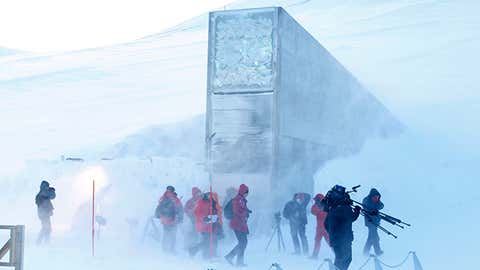At a Glance
- Norway's Global Seed Vault was partially flooded during the winter, and it's believed melting permafrost was the culprit.
- The vault holds seed samples for thousands of crops in the event of a catastrophe.
- None of the seeds were harmed by the flooding, as the water froze quickly after it entered the entrance tunnel.
A seed vault in the Arctic that's supposed to preserve the world's food supply for hundreds of years was partially flooded in recent months, and one of the reasons it was built in the first place is believed to be the culprit.
The Global Seed Vault, located on Norway's Spitsbergen Island, took on water during the winter because of melting permafrost, according to the Guardian. As the Arctic continues to set record highs, the permafrost was pushed above the melting point, and water seeped into the vault which is built into a mountain, the report added.
Because the vault's interior is kept at subzero temperatures, the water only leaked into its entrance before freezing, and none of the nearly one million packets of seeds were harmed, the Guardian also said.
"It was not in our plans to think that the permafrost would not be there and that it would experience extreme weather like that," Norwegian government spokesperson Hege Njaa Aschim told the Guardian.
(MORE: Sharp Rise in Flooding Ahead for World's Poorest)
It's known as the "Doomsday" vault because it contains seeds for every crop civilization would need to resume life in the event of a catastrophe. The vault keeps seed samples – and duplicate samples – preserved under certain conditions for such an occasion in case it ever happens.
"This is a seed collection, but more importantly it is a collection of the traits found within the seeds: the genes that give one variety resistance to a particular pest and another variety tolerance for hot, dry weather," said the American Scientist in a 2016 report.
The vault is built to survive natural disasters and nuclear war, but the winter's permafrost melt has left scientists scrambling for ideas to keep the meltwater out. As global warming accelerated in recent decades, the Arctic warmed faster than the rest of the planet, and that trend is expected to continue.
Vault managers have started to dig trenches to keep the meltwater out of the entrance tunnel, and they're performing other waterproofing measures as well. They're hopeful they can keep the vault from flooding if the permafrost melt is the new normal, and they're determined to do whatever is necessary to protect the seeds.
"We have to find solutions," Aschim told the Guardian. "It is a big responsibility and we take it very seriously. We are doing this for the world."
MORE ON WEATHER.COM: Svalbard Global Seed Vault




